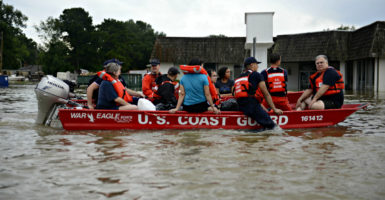Is man-made global warming to blame for the heavy rainfall and flooding in Louisiana? Former Vice President Al Gore sure thinks so.
And The New York Times ran a story with the title “Flooding in the South Looks a Lot Like Climate Change.” But the climate research suggests otherwise.
Speaking in Houston to train more grassroots activists on global warming, Gore said: “These kinds of record downpours—that’s one of the manifestations of the climate crisis.”
The Times article led with: “Climate change is never going to announce itself by name. But this is what we should expect it to look like.”
Torrential rain and severe flooding tragically claimed at least 11 lives in southern Louisiana and affected more than 40,000 homes. Emergency responders and other volunteers rescued more than 30,000 people and 1,000 pets.
But is man-made global warming to blame? Climatologists Patrick Michaels and Paul Knappenberger point to two recent studies that indicate not.
In one study, two researchers at the University of Iowa specializing in hydroscience and engineering conclude that “over the last 65 years, the stronger storms are not getting stronger, but a larger number of heavy precipitation events have been observed.”
The larger number of precipitation events, however, were not a result of burning of conventional resources of energy such as coal, oil, and natural gas. The study finds that “the climate variability of both the Atlantic and Pacific oceans can exert a large control on the precipitation frequency and magnitude over the contiguous USA.”
In other words, changes in the ocean are the reason for these increases in precipitation.
Another study, published by the American Meteorological Society, analyzes model projections and actual observed trends in heavy precipitation throughout the U.S.
The lead author is Karin van der Wiel of the National Oceanic Atmospheric Administration’s Geophysical Fluid Dynamics Laboratory. Van der Wiel and her team concluded “no evidence was found for changes in extreme precipitation attributable to climate change in the available observed record.”
Knappenberger also points to a NOAA study from June 1978, when the media and climate concern centered on the next ice age and global cooling. As he puts it: “Lower Louisiana is a climatologically prime location for massive precipitation amounts.”
What about globally? After all, man-made warming is supposed to be about global warming, right?
The latest report from the Intergovernmental Panel on Climate Change found evidence for increases, decreases, and no trend at all in flood activity or severity. The report says:
In summary, there continues to be a lack of evidence and thus low confidence regarding the sign of trend in the magnitude and/or frequency of floods on a global scale.
Trends in local events, such as hail and thunderstorms, were also inconclusive.
So whatever your theory on climate change and floods is, the U.N.’s climate change panel has studies to back you up—which suggests a lot of uncertainty in the field.
Here’s the real kicker, though: Even if it were definitively conclusive that man-made carbon dioxide emissions contributed directly to more intense and more frequent storms, the Obama administration’s regulatory climate agenda would be a costly nonsolution.
The higher energy prices paid by Americans from shuttering coal-fired power plants, regulations on oil and gas extraction, and emissions restrictions on vehicles and trucks will be for naught. In fact, cutting off virtually all economic activity and bringing U.S. greenhouse gas emissions down to zero would moderate warming by only 0.137 degree Celsius over the next 84 years.
For the Al Gores of the world, it’s convenient to point to the Louisiana floods, Superstorm Sandy, Hurricane Katrina, or the tornado in Joplin, Missouri, as evidence of man-made global warming. The facts, on the other hand, are inconvenient.
























